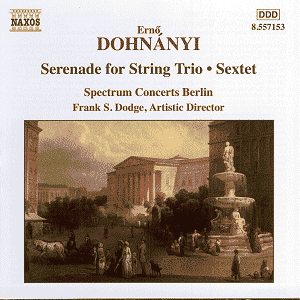Spectrum Concerts Berlin is a sensitive, responsive
group of musicians who do Dohnányi’s cause a great service
with this disc. It is a pity that they could not fill up more
of the recordable space the medium of CD offers. In fact the playing
time leaves nearly half an hour spare for another piece. Coming
hard on the heels of the recent Caprice disc of Dohnányi’s
Violin Sonata in C sharp minor, Op. 21 of 1912 (played by Cecilia
Zilliacus, violin and Bengt-Åke Lundin, piano on CAP21612:
see review), it would appear we are in a prime position as record
collectors for a reappraisal of this composer.
Actually, the Op. 10 Serenade for string
trio has been fairly well represented. Heifetz, Primrose and Feuermann
recorded it in 1941. For a more recent account, the Schubert Ensemble
of London is on ASV and the Vienna String Trio is on Calliope.
The Serenade was written in 1902. It opens with a brief
March. Spectrum Concerts Berlin provides well-pointed annunciatory
statements here, but equally take any opportunity for lyricism
offered. The second movement Romanza and the fourth movements
Theme and Variations are the highlights of the performance. Joël
Waterman’s viola sings sweetly to usher in the Romanza, spun over
a pizzicato accompaniment. The Theme of the fourth movement is
given in heartfelt fashion. A bright and vital Scherzo separates
them.
The coupling is interesting. Dohnányi’s
Sextet in C, Op. 37 dates from 33 years later. It is a
bigger-boned work, but possibly not the greater of the two. Schiff
recorded this for Decca in the 1980s (with, amongst others, the
Takács Quartet). The Endymion Ensemble brought their version
to the listings in the 1990s. Spectrum Concerts Berlin plays the
music for all it is worth, and the piece benefits from this sort
of treatment. Certainly the dynamism of the opening (note Ron
Schaaper’s vibrato-ed horn!: a nod towards Eastern Europe?) reveals
a reading that takes the music towards the hyper-romantic on occasion.
The fluent piano writing is creditably realised by Daniel Blumenthal
(the coda is virtuoso material). If some moments in the Intermezzo
could have been real magic (but are not, here), the third movement
is distinguished by some cantabile horn playing (around
six minutes in) and an expressive clarinet joins in to good effect.
The finale is jolly (the interesting waltz-interruption gives
a nice comic effect).
These are highly musical performances. The recording
requires a little more resonance (pizzicati come across as very
dry, for example, and some extra bloom around the sound would
have added to the experience). However, well worth delving into.
Colin Clarke

